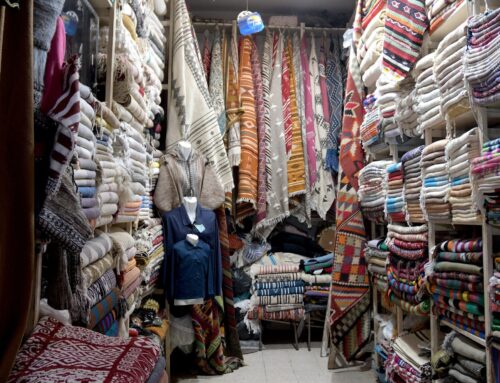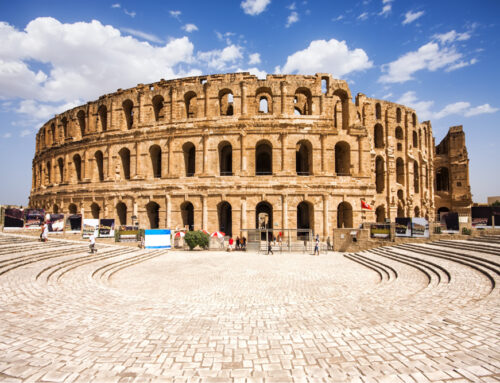Tunisian carpets might not be able to fly, but the beauty and originality of their colors and designs make them truly magical. Many travelers who take one of our Tunisia tours say their visit to a carpet shop was a highlight of their tour. Part of the reason is that every carpet has history and culture connected with it. Carpets were part of life in Tunisia long before it became a popular tourist destination. Berbers throughout North Africa raise sheep and goats, so wool has been a widely available resource they’ve put to great use. Today women throughout Tunisia make carpets in their homes to use for their families and to sell as extra income.
As you might expect, there are many carpet shops throughout the country that cater to travelers. It’s good to have some orientation before you visit a carpet shop. Here I’ll take you through the most common types of Tunisian carpets, followed by some practical tips for your visit.
1) Zarbeeya: Tunisia’s Hand-Knotted Wool Carpet
Zarbeeyas are most common in Kairouan, although you’ll see them throughout Tunisia. These carpets come from the Persian tradition. They are the most typical carpets in that they have a raised feel to them (called a “pile”) and their designs are knotted into the carpet as part of the weaving process.
When you go into a zarbeeya shop, the sellers will refer to the carpet’s knots per square centimeter. For Tunisian carpets, the most common numbers are 20, 30, and 40 knots per cm². So what does this mean? A carpet with a higher number of knots per cm² (such as 30 or 40) uses more material, has more intricate patterns, a finer texture, and is not as high off the ground. A carpet with a lower number of knots per cm² (such as 10 or 20), has a higher pile and the patterns are not as detailed.
2) Mergoum: Tunisia’s Traditional Embroidered Flat Woven Carpet
Mergoums are commonly made in the interior and south of Tunisia. They have geometric patterns and often use bright, beautiful colors. They’re also made with wool, but are flat as they have no pile. Mergoums are versatile in use, and are especially nice under a dining room table.
3) Kilims: Tunisia’s Embroidered Carpet with Berber Motifs
Kilims are similar to mergoums. Instead of geometric patterns, they feature Berber motifs such as fish, candlesticks, hands, and the symbol of the Amazigh warrior. They’re sometimes made with a mix of wool and other fabrics, so they tend to be cheaper than mergoums. They are also versatile in use. They look beautiful as a long hall rug, or hanging as a decoration on a wall.
4) Berber: Tunisia’s Thick-Pile Wool Carpet
In Tunisia, there’s a carpet referred to as a “Berber,” which is different than a Berber rug in the West. The “Berber” rug in Tunisia is a cream-colored carpet with a very thick-pile. It works great during winter time for a cold tile or wood floor. These carpets are also known as guetiffas.
Tips for Buying a Carpet in Tunisia
There are carpet shops in every medina (old city) in Tunisia, and visiting one is an experience that’s worth your time. A good carpet shop will have a large variety of styles, sizes, colors, and designs.
Some additional tips to make the most of your visit:
- Before your visit, decide what size carpet you want, and where it will go in your home.
- When you bargain with a shopkeeper, expect to settle on a price that’s about 20-30% less than the original asking price.
- If you’re not interested in buying, but still want to look around in a shop, let the shopkeeper know this at the start. This gives him the option to let you browse on your own without unrolling all the carpets.
- If you’re buying a Kairouan-style zarbeeya, look for the quality-certified stamp on the back. This certifies that the National Office of Tunisian Handicrafts has inspected the carpet. They assure that it’s handwoven and made of pure wool.
- Probably the most helpful thing you can do is look around at what’s available in several shops. After you’ve done this, you can go back to make a purchase at a shop you liked.
- Ask lots of questions about the carpets. You can learn a lot about Tunisian history and culture by asking which part of Tunisia they’re made, how they’re made, and about the meaning of the designs.
For whatever reason, carpet sellers in North Africa and the Middle East have gotten a reputation for being too pushy. Don’t let this stereotype keep you from visiting a carpet shop in Tunisia. In my experience, the pushy salesmen are the minority, not the norm. Have fun, and learn lots!
Tunisian Carpets: Culture, History, and People
In Tunisia where carpets are mostly hand-made in homes, there’s so much culture and history behind them. It’s an aspect of the culture you shouldn’t miss on your Tunisia tour. Shops are full of the beautiful colors, patterns, and designs of different carpets. I highly recommend you visit a carpet shop if you’re planning a visit to Tunisia, whether it’s in Kairouan, one of the many medinas, or on the edge of the Sahara in southern Tunisia. As always, feel free to contact us for more information about travel in Tunisia, or for help with booking your tour.








Hi I have a beautiful Tunisian rug I wish to get valued it has a cream background and is 7 pot square my parents bought it for me while on holiday in Tunisia in 2005: it was especially made and was shipped to the UK . I am moving house and it is to large to keep
Hello! Your cream colored Tunisian rug sounds beautiful! Sorry to hear you’ll have to part with it. I’m not sure about how pricing of original hand-sewn carpets works in the UK, but in Tunisia they last for several decades because they’re made of mostly wool. Because of this, they generally maintain their value here if they’re kept in good condition. If it is in good condition, here in Tunisia you would likely value it close to the price you bought it at, perhaps a little lower but not significantly. Would it be possible to find a UK carpet seller on the internet that specializes in hand-made carpets, and get a quote from them?
Thanks for stopping by, and good luck!
Austin
I purchased a Berber wool rug in Kairouan in 1979, and have loved it. It was still on the loom when I saw it, and it was shipped to me very reasonably.It has been part of my living room through 7 moves, across 4 countries! Finally I have had to part with it, because my housekeeper managed to spill acid. Thy wear so well that I am looking for another…but I have not yet seen a similar pattern.I am enjoying going through various web sites and trying to decide! I live in Central America, so any rug would need to be shipped.
Hello, i am going to visit Tunisia next month by motorcycle and i intend to buy a carpet not big one to carry it easy with my motorcycle. I am just wondering if i am gonna have any kind of issue during leaving the country by the border control?
Great to hear about your upcoming trip by motorcycle to Tunisia! I wouldn’t anticipate any issues taking a carpet out of the country especially if you have a receipt of the purchase. Enjoy your travels and wish you a fantastic experience!
Thanks for all the great tips! We have our final stop in Djerba and are hoping to buy a rug or two there – if you have any tips of the best places to get them on the island that would be amazing :)
Thanks for your note and glad the article was helpful! We don’t have any specific suppliers we know in Djerba, but I imagine if you do some exploring in Houmt Souk you’d be able to find some great options. Good luck and enjoy your time!